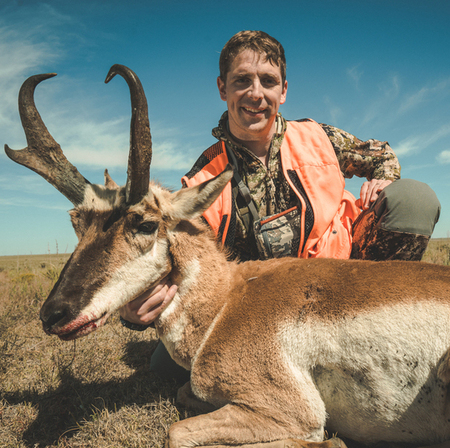Essential Coyote & Hog Hunting Tips from 6 Experts

Coyote hunting is exciting for any hunter, but it's not easy. A hunter needs good skills, proper gear, and passion. For beginners, coyote hunting or hog hunting it can be more challenging than hunting deer or other animals. But that makes it even more thrilling.
We want to help our readers learn more about how to haunt the right way so we reached out to 6 hunters and asked them the following questions:
What are your best coyote hunting tips?
Keep reading to see what they had to say.
Clay Belding - The Fowl Life
When setting up on a coyote stand, always put your e-caller upwind from where you are sitting and always leave your downwind side open.
Coyotes tend to work downwind from the sound so if you have the e-caller even or downwind from you, you will get busted from the coyote more often than not.
So, with the e-caller upwind from you, they will come downwind to the sound and straight into you.
Now, if they go even further downwind from you, and they bust you, by leaving your downwind side open, you will at least have a shot in the open area. If you have a very thick area on your downwind side, you would never see them, let alone get a shot off.
Kevin Paulson - Hunting Life
Hunting predators like coyotes are essential to the balance of your herd whether you are focused on whitetail deer, mule deer, turkeys or pheasants. Taking just one coyote off the land you hunt can make a dramatic difference in your success in future years.
Coyotes are focused on 3 basic things in life, food, sleep, and sex. I primarily like to hunt coyotes after the season has ended for deer and pheasant.
That usually means January and so I focus about 80% of my calling on mimicking other coyotes like pups and females.
I find this works more often then I focus on rabbit distress calls as the last resort. Electronic calls like those from FoxPro work best for big country like we hunt because they have the ability to punch through really big winds and travel long distances
When I am approaching coyote sets, I always focus on wind and height. I want to put myself and my team in a position where we can see as many coyotes coming from as far a distance as possible. That gives us plenty of time to get set up for a shot.
I always pay attention to where I believe the coyotes are going to come from and the prevailing winds. There are times when I am absolutely wrong and the coyotes quickly wind me but I get a little better each season.
You cannot kill coyotes from the comfort of your couch so the best way to have success in the field is to get out in the field as often as possible.
Dawn Freeland - Women Hunt Too
Whether it is a handheld call, a mouth call or an electronic call, invest in a good one and learn how to use it before you go out hunting.
Also, invest in a good decoy. The most popular are the electronic rabbit decoys. They work well on coyotes.
Some hunters use bait to entice a coyote or two to come closer.
Make sure you wear camouflage head to toe. Check to make sure your gun or other shiny items are well covered as well.
(Please be sure to check with your state on the rules and regulations regarding these and other requirements.)
Do your homework ahead of time:
-Scouting out the different areas and looking for signs of coyotes.
-Watch lots of videos and learn what to expect when you are out in the field.
-Practice setting up your decoys and figuring out how to use them ahead of time.
Relax and have a good time. When you hear those coyotes answer you back the first time, it will send shivers up your spine, not to mention the added bonus of goosebumps.
Remember coyotes can decimate the local deer herd in no time. We need to manage them as much as possible. After all what animal hunts and kills coyotes? Not many.
The most common predators that eat coyotes include bears, cougars, wolves, mountain lions, and on rare occasions, other coyotes.
That is why it is important to hunt and keep their numbers down.
"Anytime I am deer hunting and I see a coyote, it now becomes coyote hunting instead"
What are your best tips for hog hunting?
John McAdams - The Big Game Hunting Blog
Feral hogs can have gigantic home ranges and it’s not unusual for them to travel long distances in a short period of time. There might literally be dozens of them in a small area one day, but then they could be miles away the next day.
For that reason, it’s important to focus your hunting efforts in areas where the hogs are likely to be right now and not where they were last week.
Feral hogs are particularly dependent on water, so search in low lying areas like creek bottoms where you’re likely to find a reliable source of water along with plenty of covers.
Keep the wind in your face and slowly, quietly, and carefully walk through the area. Carry firearm or a bow with you when you do that because you might just discover some hogs while you’re scouting!
Look for fresh hog sign like tracks, droppings, and recently used wallows. If you don’t find a fresh sign, then don’t waste any more time in that area, move onto a new place, and repeat the process until you find recent signs of hog activity. If you do find a fresh sign, then you’ve found an ideal spot to hunt.
Jerry Slade - Michigan Whitetail Properties
1. Know-How to Track a Hog
You have to look for the proper prints, but not get them confused with deer prints. Hog prints have a similar structure to a deer hoof, but hog prints tend to be more rounded.
Oftentimes near hog prints, you will also find uprooted soil as hogs like to dig in the fresh soil with their snouts for food. If you see a print similar to a hog near uprooted soil then it is most likely from a hog.
2. Don't Scare Them!
- Hogs have a good sense of hearing and smell. Just as it is important for any game you are hunting, you have to keep the proper distance so you don't spook them. Wear proper camouflage and stay low.
While they don't have great eyesight, if you don't say low, you are making yourself more vulnerable to be seen by a hog.
3. Consider Hunting at Night
Many hogs have become nocturnal due to being hunted and spooked during the daytime which means many have become accustomed to coming out at night. If you want a good shot at bagging a hog, you should consider hunting at night.
4. Aim for the Heart, Lungs, or Head
Hogs have some thick skin. It's important that you aim for a part of the body that can give you a direct kill. If you aim above the elbow, you will have a direct hit of the heart and lungs area.
If you aim behind the ear, you will have a direct hit of the brain. If you don't aim for one of these areas, you may just injure the hog without killing it.
5. Use Ammo that can Penetrate
For the same reason that you want to aim for a specific kill zone, you want to have the proper ammo that can penetrate a hog's thick skin.
6. Use Calls or Scents
You should find yourself a good female hog call that will attract large males to your hunting area. I have seen great success with that. Also, hogs like the smell of berries and molasses. Go get yourself a good scent spray that you can use. The combination of the call and scent can be a game-changer for you.
Jerry Eulitt - Ike's Outdoors
We like to bow hunt for hogs. When we set up our bows for hogs we like to go with as heavy a draw weight as we can comfortably handle and hold.
We also beef up our arrow weight. We like to stay above 450 grains to get the maximum momentum out of the arrow. Fixed blade heads also provide a bit of extra penetration and durability if a heavy bone is contacted.
Call Types and Techniques
The right call can make or break your hunt. Coyotes respond best to distress calls – especially when they mimic a dying rabbit or fawn. Electronic calls are popular thanks to their volume and realism. Still, a skilled hunter can get great results with mouth-blown calls.
Hog calls, on the other hand, are better for imitating the sound of feeding sows. They attract dominant boars that are looking for competition.
When it comes to calling coyotes or hogs, timing and cadence matter. If you overcall, you can spook the game, but a well-timed pause can create curiosity. There’s no exact formula, but nuance that hunters develop with experience.
A mix of howls, barks, and distress sounds work well for attracting coyotes. For their part, hogs react best to feeding grunts and distress squeals. You should experiment with different sequences until you find what works in your hunting area.
Equipment and Gear Selection
Of course those aren’t the only coyote hunting tips and hog hunting tips.
Success in both coyote and hog hunting requires quality gear. Night vision and thermal optics give hunters a huge advantage. This is particularly true when they target nocturnal animals. You can find top-rated thermal scopes and night vision gear at Night Vision Guys. There are plenty of products designed for serious hunters.
Rifles chambered in .223 or .22-250 Remington are popular for hunting coyotes because of their flat trajectory and long-range efficacy.
With their thick hides and tough bone structure, hogs require heavier calibers like Winchester .308, the .450 Bushmaster, or a 6.5 Creedmoor. You can avoid startling other nearby game when you shoot with suppressors, which also suppress recoil.
Wind/Scent Management
Coyotes and hogs both have incredible senses of smell. One of the biggest reasons hunters walk away empty-handed is the failure to manage scent. Always hunt with the wind in your favor. When you set up, make sure your scent is carried away from where you expect the game to approach.
You should cover scents, and scent-eliminating sprays to help with this situation. But remember that nothing replaces smart positioning. If the wind were to shift, be prepared to move. Some hunters even store their hunting clothes in bags with natural materials like pine needles or dirt that help mask human odors.
Setup Strategies
It matters where and how you set up for your hunt. Coyotes prefer open fields and fence lines where they can see their prey. But hogs like brush and wooded areas. You can increase your chances of spotting them before they detect you by setting up on the edge of clearings.
Elevated positions also give better vantage points. Especially when taking long-range coyote shots, you can improve your accuracy with a quality bipod or shooting sticks.
If you’re hunting hogs at night, you should use red or green lights to illuminate targets without alerting them.
Locations/Scouting
Successful hunters scout before they hunt. You can gather valuable intel by checking trail cameras placed near water sources, game trails, and known feeding areas.
Coyotes tend to roam large territories, so you can increase your success rate by locating den sights and travel corridors. Hogs actually leave clear signs of their presence through wallows, rooted-up soil, and tracks near water.
Hunting on public land requires extra research. You’ll want to check regulations, talk to local hunters, and study maps of terrain to find productive hunting spots. Private land can allow for greater control over conditions depending on your location, so it’s often worth the effort to secure permission from landowners.
Population Management
Predator control is so critical if we want to maintain a balanced ecosystem. Coyotes threaten livestock, game animals – even pets. Regular hunting helps to keep their numbers in check.
Hogs can breed at an alarming rate. In fact, sows produce multiple litters every year. Without population control, they quickly destroy crops and damage ecosystems. Because of this, many states encourage year-round hog hunting to try and curb their spread.
Protecting Other Wildlife/Livestock
Protecting other animals is also a goal of coyote and hog hunting. Coyotes typically prey on deer, rabbits, and even ground-nesting birds.
Farmers and ranchers rely on hunters to protect their livestock from an overpopulation of coyotes. Common targets include lambs, calves, and poultry. As more homes encroach on their territories, coyotes have even been known to kill pets.
Feral hogs can devastate farmland. They consume crops and destroy habitats. Plus, their aggressive nature poses a significant risk to both other animals and humans. The most effective means of control is hunting, which is why many landowners welcome responsible hunters to help manage these populations.
Disease Control
Both hogs and coyotes carry diseases that can spread to humans and other animals. Coyotes are known to carry rabies, mange, and distemper. Hogs often host parasites and diseases like brucellosis and pseudorabies. Both of these illnesses can infect domestic livestock.
To prevent disease transmission, proper handling and disposal of carcasses is paramount. Make sure you wear gloves when field dressing, and thoroughly cook the meat before consumption.
Off-season Hunting Opportunity
Coyote and hog hunting differ from deer and turkey season in that the former often offers year-round opportunities in many places. Still, many hunters use the off-season to refine their skills, test new gear, and keep their shooting skills sharp.
Some states actually offer bounty programs for coyote kills. They provide financial incentives for hunters. Due to their invasive status, hog hunting is often unrestricted. That makes them a great off-season target. Just make sure you investigate the laws in the area you’ll be hunting.
Skill Development
Every hunt is its own learning experience. The best hunters adapt to changing conditions, study animal behavior, and refine their tactics as time goes by. You can help achieve long-term success when you practice at different ranges, improve stealth skills, and experiment with new strategies.
Mentorship can be invaluable to a hunter. The learning process is accelerated when you learn from experienced hunters. Why not network with local hunters for insights into what techniques work best in your area?
Coyote Behavior
Coyotes are intelligent and adaptable animals. They hunt either alone or in pairs, and they often use clever tactics to lure their prey into the open. Mating season influences their movements as males grow more aggressive and vocal in search of a mate.
Understanding coyotes’ habits – where they den, what they eat, and how they communicate – helps hunters predict the animals’ movements.
Coyotes are naturally curious, but they’re also wary. Since they can quickly learn to recognize common hunting tactics, adaptation is key to success.
Feeding Habits
Coyotes are opportunistic eaters. They primarily consume small mammals like rabbits, mice, and squirrels but won’t hesitate to scavenge carrion or steal pet food. They adjust their diet based on availability, even eating fruit or insects if necessary.
Hogs, on the other hand, are relentless feeders. They root through soil for grubs, eat agricultural crops, and consume anything they can find. Their diet makes them destructive, which is why landowners seek to control their numbers.
Population Growth/Distribution
Coyote populations have really expanded all across North America. They can thrive in rural, suburban and even urban environments. That adaptability makes them hard to eliminate.
Hogs have also spread rapidly across the United States. Their populations are now found in at least 35 states. Because of their high reproduction rate, the animals are hard to control. Without hunting, their numbers would skyrocket, and they would cause widespread ecological damage.
Physical Characteristics
Coyotes have sharp senses. They possess excellent eyesight, smell, and hearing. The canines average about 30–50 pounds with lean and agile bodies that are built for endurance running.
Hogs, on the other hand, are stocky, muscular animals that have thick skin and coarse hair. With their powerful shoulders and strong jaws, hogs are formidable opponents when cornered.
Tracking/Signs
If you want to successfully hunt coyotes or hogs, you must learn to read their tracks and signs. Coyote tracks look similar to a domestic dog’s, but they are more oval and compact. The animals leave scat with fur and bone fragments, which indicates their diet. Their trails typically follow fence lines, open fields, and creeks.
Hog tracks have a distinctive round shape. These swine’s wallows, rooted-up soil, and game trails all are clear indicators of recent activity. If you see fresh tracks and scat, then hogs may be nearby. But if you identify older signs of hogs, chances are they’ve moved on.
Successful Coyote Hunting Tips and Hog Hunting Tips
Both hog and coyote hunting require patience, skill, and the right equipment. Preparation and knowledge boost your odds of success, whether you’re calling a wary coyote or tracking a sounder of hogs.
Night Vision Guys offers serious hunters plenty of high-quality optics and gear that are designed to give an edge in the field. You can shop for the latest thermal scopes, night vision goggles, and hunting accessories that will take your hunts to the next level.
Thank you so much to all the hunters that shared with us their experience! If you enjoyed reading this post, please share it with your friends and followers on social media.
If you’re new to coyote or hog hunting and need sights for day & night, be sure to check out our thermal devices, night vision scopes, and more!






















